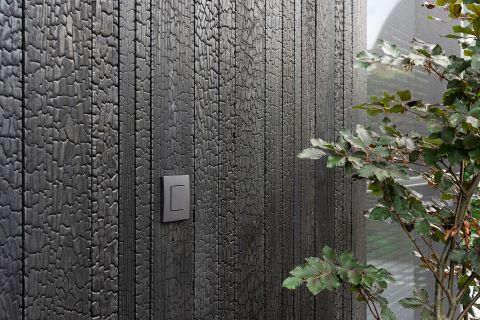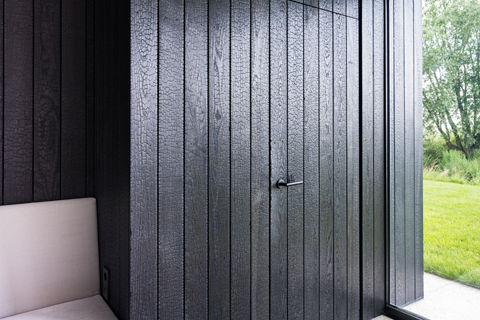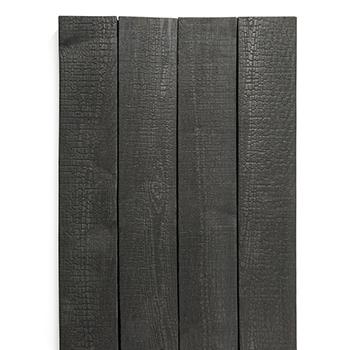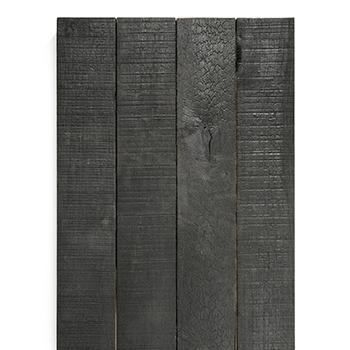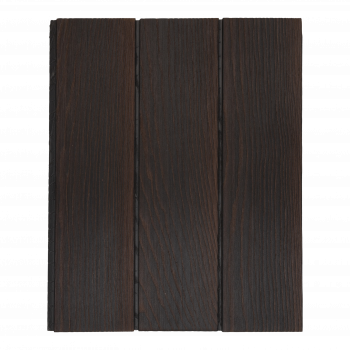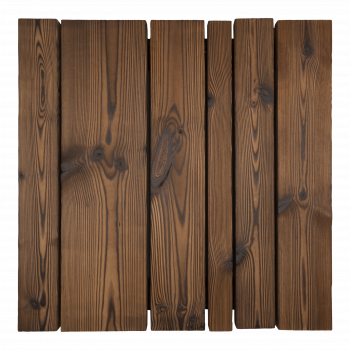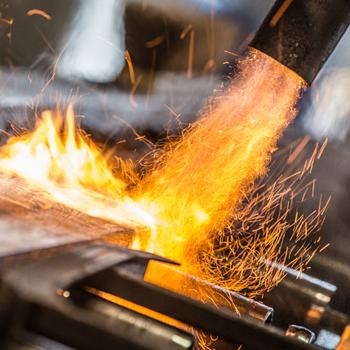Shou Sugi Ban, a Japanese tradition
In Japan, cypress wood was traditionally charred to help prevent the spread of fire and to protect wood against insects and mould. The ancient technique known as Shou Sugi Ban is still in use today and can be found in both traditional and modern buildings. After renowned Japanese architect Terunobu Fujimori began incorporating burnt wood in his designs in the late 20th century, it began to show up in Western countries as well.
Beautiful black wood charred in our own workshop
At Carpentier the wood is ‘burnt’ to create a charred layer that is resistant to the effects of weather. We apply this Shou Sugi Ban technique to thermo ash, thermo pine, Accoya and Douglas fir in particular, since it creates a beautiful, lived-in look while ensuring stability.The Japanese burnt wood finish can also be applied to other wood varieties upon request, including and oak.
Charring accentuates the particular texture and appearance of each wood variety, making every board unique. And almost any result is possible, from lightly toasted to deep black. We can also brush wood before or after charring. A stabilizing finish preserves the charred layer and has a maintenance-reducing effect.
We advise using charred douglas and charred oak wood for interior projects only.
Good to know
Minor surface damage to the outer layer of the charred wood may occur during transportation, processing and installation. Carpentier accepts no responsibility for this.
Why char wood?
Controlled surface burning improves the durability of the wood and produces an attractive charred finish that is harmonious and stylish. Another important feature of black wood is that it is flame retardant, since having already been fire-treated it is less likely to ignite. Burnt wood is also highly resistant to insects, mould and UV damage. The charred layer retains its colour and develops a beautiful patina over time.
Exceptional beauty for indoor and outdoor projects
Our black wood is an outstanding and durable choice for cladding of exterior walls and the wooden gates and fencing that we offer in ready-to-use kits. It is also ideal for interior projects such as wood panelling.
Ready to see more? Beautiful examples of black charred wood projects can be found on our projects page. If you have any questions or would like to plan an appointment to visit our showroom, please do not hesitate to get in touch.
-
The many advantages of our charred wood
- Tailor-made solutions in finishes ranging from lightly toasted to deeply charred
- A beautiful, authentically aged appearance
- A finish that brings out the particular beauty of each wood variety
- A natural finish that remains stable, not changing colour when exposed to wind, rain and sun
- Fire-resistant and unaffected by fungus and insects
- Maintenance-free thanks to our fixing finish
- Perfect as interior panelling, but also for cladding on exterior walls, wooden gates and fencing
- Quick delivery
Charred wood possibilities
At Carpentier, our finishes are always tailor-made. This is how we ensure the perfect end result for your project. We offer a variety of finishing options:
- Light charring: we only ‘burn’ the wood’s outer layer, which creates a soft black or toasted effect. This also brings out the grain slightly.
- Medium charring: we burn the wood a little deeper, adding more texture and resulting in a darker black colour.
- Intense charring: we deep burn the wood, giving it an intense black colour and a rich texture.
- Black staining: we oil, brush and emboss the wood. This is a cheaper alternative to charred wood.
A beautiful alternative for a Japanese burnt wood finish: HOTwood pine Ignite
In appearance, our Ignite tongue-and-groove boards in thermo pine are identical to the characteristic beauty of our charred woods. The major difference is that Ignite lacks the blackened, charred layer of wood finished with the traditional Shou Sugi Ban charring method. To achieve the texture of a burnt wood, thermally modified pine is embossed and brushed, then given a black finish.
This unique, aesthetically pleasing profile is a budget-friendly alternative for charred wood, but offers the same level of durability as thermo pine. Moreover, it is incredibly low-maintenance, requiring no more than a coat of black paint every five to seven years. With regular painting, the charred effect will remain intact for years. Ideal for interior and exterior projects.


